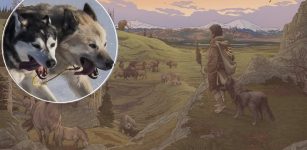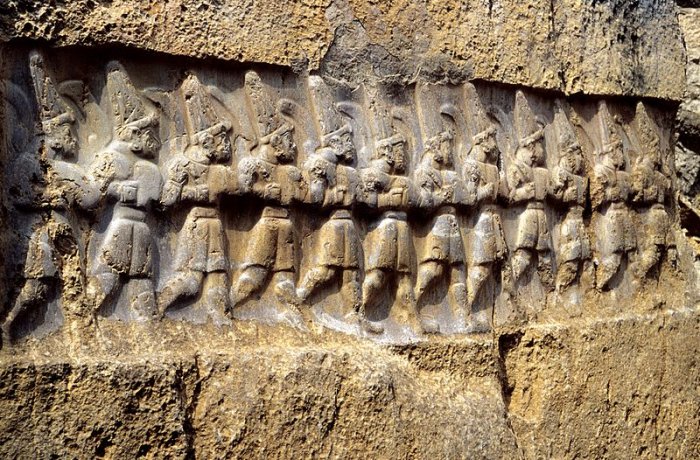Yazılıkaya: One Of The Most Striking Religious Shrines Of The Hittite Empire
A. Sutherland - AncientPages.com - The fascinating ancient Hittite sanctuary of Yazilikaya ('rock with writing') lies between rock outcroppings at the foot of the high ridge east of Hattusha, 170 kilometers east of Ankara and near the small town Boğazköy (Turkish: "Gorge Village") modern Boğazkale, Turkey.
Lion Gate, Hattusa, Turkey. Image credit: Bernard Gagnon - CC BY-SA 3.0
Archaeologists date the earliest settlement in the city of Boğazköy, which was discovered in 1834, to 3000 BC. Still, nothing is known about the identity of the first settlers of Boğazköy because there are no written documents that could shed light on the local history of this region.
However, remains of the ancient 'Great Fortress' (Büyükkale) on the east side of Boğazköy confirmed that it later became the acropolis of the Hittite kings.
The earliest written sources found at Boğazköy are clay tablets inscribed in cuneiform writing in the Old Assyrian language.
An open-air Hittite sanctuary, Yazilikaya, is one of the most striking religious shrines of the Hittite Empire (1400-1200 BC), and many gods and goddesses were worshiped there during this time.
Yazilikaya, Hittite sanctuary near Hattusa, Turkey, Chamber B Procession of the 12 Underworld Gods. Image credit: Klaus-Peter Simon - CC BY 3.0
Worshippers would pass through the temple and find themselves in the rock sanctuary with walls richly decorated with bas-reliefs depicting Hittite deities in pointed caps or magnificent tiaras on their heads.
Many rock reliefs exist in other Hittite sites, but they are smaller and more impressive than the galleries of gods at Yazilikaya. The reliefs in the shrine's main chamber include two long processions of gods that converge on a large rock face at center stage, where the famous Weather God of Heaven, Teshub, faces his consort.
Teshub was worshipped as the "King of Heaven, Lord of The Land of the Hatti." He is depicted as a bearded man, dressed in a kilt, with an ax in his belt, holding a spear in one hand and a symbolic flash of lightning in the other.
The gods are depicted on the west, and the goddesses on the east side of the gallery. Unfortunately, archaeologists have been able to identify only a few of these prominent figures.
Sharruma, the son of the two great gods renewing their marriage vows, stands right behind his mother and leads the line of divine ladies. On the west wall of the sanctuary, Shaushga, the Hittite version of the planet Venus as the goddess of war, marches with the men.
 Left: Rock carving in Chamber B depicting god Sharruma and King Tudhaliya dated to around 1250 - 1220 BC. Image credit: Klaus-Peter Simon - CC BY 3.0; Right: Nergal, the underworld god in the era of Old Assyria and Old Babylonia. Image credit: Klaus-Peter Simon - CC BY 3.0.
Left: Rock carving in Chamber B depicting god Sharruma and King Tudhaliya dated to around 1250 - 1220 BC. Image credit: Klaus-Peter Simon - CC BY 3.0; Right: Nergal, the underworld god in the era of Old Assyria and Old Babylonia. Image credit: Klaus-Peter Simon - CC BY 3.0.
Archaeologists also recognized Telipinu, the son of the weather god and the patron god of vegetation, holding a twig or an ear of corn. The procession has many different winged figures, but only the Moon-god from Mesopotamia is recognizable. Interestingly, the carved hieroglyphics accompanying the gods at Yazilikaya identify the gods with Hurrian names. The Hurrians founded the kingdom of Mitanni southeast of the Anatolian plateau in northern Mesopotamia and eastern Syria.
Their language was not related to the Semitic peoples of Babylon or the Hittites.
Interestingly, the carved hieroglyphics accompanying the gods at Yazilikaya identify the gods with Hurrian names. The Hurrians founded the kingdom of Mitanni southeast of the Anatolian plateau in northern Mesopotamia and eastern Syria. Their language was not related to the Semitic peoples of Babylon or the Hittites.
Puduhepa, for example, the Hittite queen, came from Kizzuwatna, a Hurrian province in the southern lands of the Hittite empire, later known as Cilicia. The daughter of a priest and as a priestess herself, she brought tablets inscribed with the names of the gods to her Hittite husband. She was married to Hattushili III (1275— 1250 B.C.), who, along with their son, Tudhaliya IV (1250— 1220 B.C.), was ordered to carve the sculptures at Yazilikaya.
Yazilikaya Chamber B, Name Cartouche Tudhalija IV. Image credit: Klaus-Peter Simon - CC BY 3.0
His carved depiction is seen at the entrance to the sanctuary. He is dressed in the traditional long robes of the Hittite kings; he wears a curved sword and carries his pictograph symbol in his right hand.
Among other identified gods depicted in the wedding procession at Yazilikaya, there is Hepat, Teshub's bride and the goddess of cyclical renewal. Hepat was the great Hurrian Mother Goddess, and at the same, to Hittites, she was the Sun Goddess affiliated with the city of Arinna, the major cult center of this Hittite sun-goddess, also known as UTU Arinna or "Sun-Goddess of Arinna."
The great shrine at Yazilikaya and its marvelous sculptures, along with an ancient text: 'All the gods assembled and entered into the House of the Weather God,' prove that the Hittite kings celebrated a great festival of Heaven and Earth at the beginning of the year.
The Hittite New Year, which occurred in spring and probably coincided with the vernal equinox, was very important and widely celebrated, by the people of Mesopotamia.
Yazilikaya remains a vital historical moment at the height of the Hittite civilization.
Written by – A. Sutherland AncientPages.com Senior Staff Writer
Updated on Oct 1, 2023
Copyright © AncientPages.com All rights reserved. This material may not be published, broadcast, rewritten or redistributed in whole or part without the express written permission of AncientPages.com
Expand for referencesReferences:
M. Chase, Hebrew, Phoenicians, Hittites
E.C. Krupp, Skywatchers, Shamans, Kings
More From Ancient Pages
-
 Sanctuary Of God Mithra And His Mysterious Religion Unearthed In Corsica
Archaeology | Mar 2, 2017
Sanctuary Of God Mithra And His Mysterious Religion Unearthed In Corsica
Archaeology | Mar 2, 2017 -
 Louvre Museum’s Entire Collection Is Now Available Online To Anyone
News | Mar 31, 2021
Louvre Museum’s Entire Collection Is Now Available Online To Anyone
News | Mar 31, 2021 -
 Beautiful And Unique Ancient Roman Hoard Discovered In UK
Archaeology | Oct 3, 2017
Beautiful And Unique Ancient Roman Hoard Discovered In UK
Archaeology | Oct 3, 2017 -
 Greek Discovery Of Stone Tools In Megalopolis Area Pushes Back Greece’s Archaeological Record Up To 250,000 Years
Archaeology | Jun 2, 2023
Greek Discovery Of Stone Tools In Megalopolis Area Pushes Back Greece’s Archaeological Record Up To 250,000 Years
Archaeology | Jun 2, 2023 -
 ‘Saimaluu-Tash’ Time Capsule: Largest Millennia-Old Collection Of Petroglyphs In Central Asia
Civilizations | Nov 20, 2018
‘Saimaluu-Tash’ Time Capsule: Largest Millennia-Old Collection Of Petroglyphs In Central Asia
Civilizations | Nov 20, 2018 -
 First People To Enter The Americas Brought Their Dogs With Them
Archaeology | Jan 29, 2021
First People To Enter The Americas Brought Their Dogs With Them
Archaeology | Jan 29, 2021 -
 Intricate Mazes And Labyrinths: Mysterious Symbols Of Beauty And Confusion Or Communication Signals
Ancient Symbols | Jun 23, 2016
Intricate Mazes And Labyrinths: Mysterious Symbols Of Beauty And Confusion Or Communication Signals
Ancient Symbols | Jun 23, 2016 -
 Tiger Cave: Rock-Cut Hindu Temple Complex Dated To East India’s Pallava Empire
Featured Stories | Jan 19, 2017
Tiger Cave: Rock-Cut Hindu Temple Complex Dated To East India’s Pallava Empire
Featured Stories | Jan 19, 2017 -
 Why Was The Face Of Mysterious Ust-Taseyevsky Stone Idol Suddenly Changed?
Archaeology | Jan 18, 2021
Why Was The Face Of Mysterious Ust-Taseyevsky Stone Idol Suddenly Changed?
Archaeology | Jan 18, 2021 -
 On This Day In History: Vlad III Dracula Regained Throne Of Wallachia For The Third Time – On Nov 26, 1476
News | Nov 26, 2016
On This Day In History: Vlad III Dracula Regained Throne Of Wallachia For The Third Time – On Nov 26, 1476
News | Nov 26, 2016 -
 Wendigo: Cannibalistic Shapeshifter In Mythology Of Indians Of North America And Canada
Featured Stories | Sep 3, 2016
Wendigo: Cannibalistic Shapeshifter In Mythology Of Indians Of North America And Canada
Featured Stories | Sep 3, 2016 -
 Was The Discovery Of Biblical Abel’s Giant Grave In Syria Covered-Up?
Ancient Mysteries | Oct 28, 2014
Was The Discovery Of Biblical Abel’s Giant Grave In Syria Covered-Up?
Ancient Mysteries | Oct 28, 2014 -
 Young Girl Finds Rare Ancient Megalodon Shark Tooth On Maryland Beach
Archaeology | Jan 16, 2023
Young Girl Finds Rare Ancient Megalodon Shark Tooth On Maryland Beach
Archaeology | Jan 16, 2023 -
 Mystery Of Monte d’Accoddi: Was It An Ancient Step Pyramid, Altar Or Astronomical Observatory?
Civilizations | May 17, 2016
Mystery Of Monte d’Accoddi: Was It An Ancient Step Pyramid, Altar Or Astronomical Observatory?
Civilizations | May 17, 2016 -
 Spells, Charms, Erotic Dolls: Love Magic In The Ancient Mediterranean
Featured Stories | Oct 24, 2022
Spells, Charms, Erotic Dolls: Love Magic In The Ancient Mediterranean
Featured Stories | Oct 24, 2022 -
 Spectacular Vardzia Cave Monastery – Huge Underground Complex Founded By The ‘Mountain Queen’ Tamar
Featured Stories | Dec 28, 2015
Spectacular Vardzia Cave Monastery – Huge Underground Complex Founded By The ‘Mountain Queen’ Tamar
Featured Stories | Dec 28, 2015 -
 Evidence Of Unknown Ice Age Civilization Discovered In Michigan Ignored By Pipeline Company!
Archaeology | Oct 16, 2020
Evidence Of Unknown Ice Age Civilization Discovered In Michigan Ignored By Pipeline Company!
Archaeology | Oct 16, 2020 -
 Aboriginal Underwater Sites Off The Coast Of Australia – Discovered
Archaeology | Jul 2, 2020
Aboriginal Underwater Sites Off The Coast Of Australia – Discovered
Archaeology | Jul 2, 2020 -
 Megaliths In Central France: 30 Prehistoric Monolith Stones And One Human Skeleton – Unearthed
Archaeology | Sep 11, 2019
Megaliths In Central France: 30 Prehistoric Monolith Stones And One Human Skeleton – Unearthed
Archaeology | Sep 11, 2019 -
 Ancient Highways Unearthed In Arabia
Archaeology | Jan 14, 2022
Ancient Highways Unearthed In Arabia
Archaeology | Jan 14, 2022



